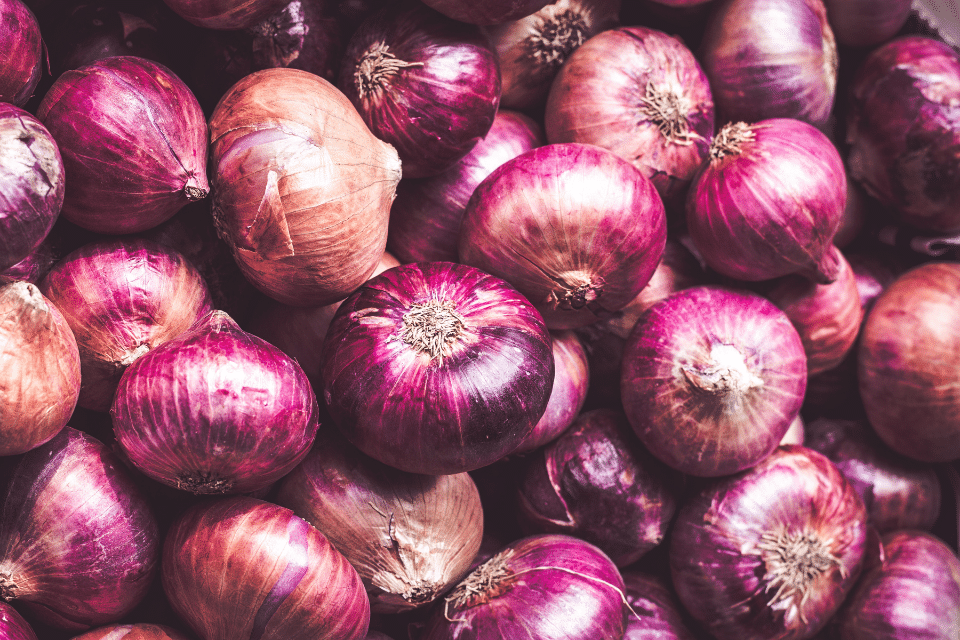If you have IBS, then you’ve probably heard of the low FODMAP diet which was created and studied by researchers at Monash University. We’ve been doing a deep dive into where certain FODMAPs hide, and today we’re going to be talking about fructans.
Fructans are a chain of fructose molecules that store carbohydrates. You might be more familiar with them as a type of oligosaccharide. Fructans are malabsorbed in our small intestine by all humans, not just ones with irritable bowel syndrome (IBS). Once they’re malabsorbed, they’re pulled into the large intestine where they’re rapidly fermented by gut bacteria. This then causes gas, which in healthy people is just a normal part of digestion. In people with IBS, this gas can cause bloating, abdominal distention, or pain, and altered bowel habits like diarrhea or constipation. So, fructans sound like trouble, right? Not necessarily! Many fructans, like onions and garlic, are prebiotics. Prebiotics are like food for gut bacteria, which is important for a healthy microbiome. The key is to figure out which fructans are causing you issues and in what amounts. That’s why completing the three phases of the low FODMAP diet is so important.
If you’re in the elimination phase of the diet or you know that some fructans can cause a lot of digestive issues for you, it’s important to know where fructans might be hiding! Read on to find out some of our tips and tricks to identify fructans hiding in your diet.
One common misconception about the low FODMAP diet is that it’s gluten-free. What does this have to do with fructans? Well, many people that think they have gluten intolerance or a gluten sensitivity actually have a fructan intolerance! The main difference between fructans and gluten is that one is a carbohydrate (fructans) and one is a protein (gluten). While someone who has celiac disease must follow a lifelong gluten-free diet, people with IBS may not actually have to avoid gluten. They may just need to limit certain fructans! So where can you find them?
Common fructans:
- Vegetables: artichokes, leeks, garlic, onions, beets, asparagus (both fructose and fructan), broccoli, Brussels sprouts, fennel, okra, shallots, and the bulbs of scallions
- Fruit: grapefruit, raisins, blueberries (high portions), dates, dried fruit, passionfruit, pomegranate, raspberries, bananas, watermelon
- Grains: wheat, barley, rye, amaranth, einkorn (a wheat variety), emmer, lupin flour, spelt, freekeh, semolina, wheat bran, and wheat germ
- Nuts: cashews and pistachios
Where they hide:
Now that you know about the common sources of fructans, let’s dive into where they might be hiding.
- Seasoning blends: We all know that garlic and onion can cause digestive issues, but what about when a piece of chicken says it’s seasoned with Adobo or Chili powder? Those seasoning blends typically contain garlic and onion powder! Be sure to read your ingredients when buying pre-seasoned protein and ask questions when eating out at restaurants.
- Sauces: Do you know what’s often used to thicken sauces? Wheat flour! Soy sauce in particular is a big culprit. Miso (a type of fermented soybean paste), is sometimes made with barley. Again, read your ingredient list and ask questions when eating out!
- Chicory root (inulin): This is a prebiotic fiber and is added to some products to boost the fiber content. It’s often found in granola bars, cereal, or other products that are labeled high fiber.
- Wheat: There are a whole lot of names for wheat out there! We already told you about a few above (semolina, einkorn, etc), but one easy tip is to look at the labeling underneath the ingredient list. By law, wheat must be listed as a potential allergen.
- Protein bars: Many protein bars are made with dried fruit like dates or raisins. While small amounts are ok, bars made entirely of dates aren’t usually well tolerated.
- Dips: Hummus, salsa, and other dips are typically seasoned with garlic and/or onion. You can still enjoy these types of food, you may just need to make your own or buy from a low FODMAP brand.
Remember, the low FODMAP diet is not a long-term diet. The elimination phase is followed by a reintroduction or challenge phase, which is when you figure out your trigger(s) for your IBS symptoms. Many people find that their triggers are portion size-dependent, or that they are gradually able to add back in their high FODMAP triggers over time.


